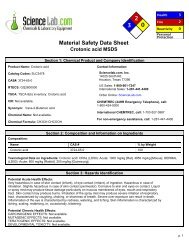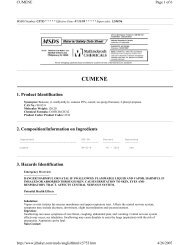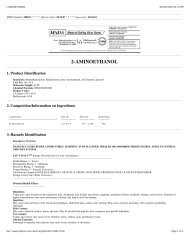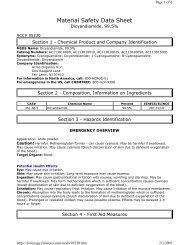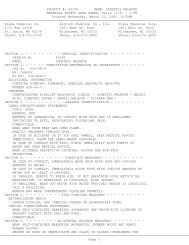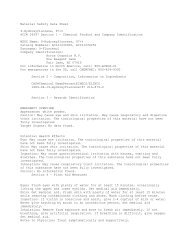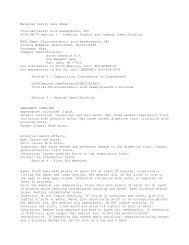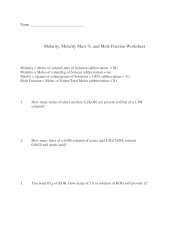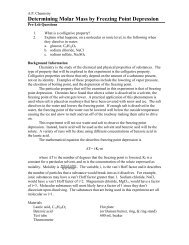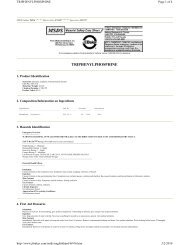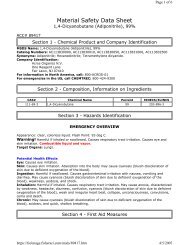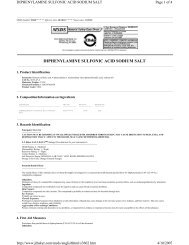Zinc Chromates.pdf
Zinc Chromates.pdf
Zinc Chromates.pdf
Create successful ePaper yourself
Turn your PDF publications into a flip-book with our unique Google optimized e-Paper software.
Easy PDF Copyright © 1998,2003 Visage SoftwareThis document was created with FREE version of Easy PDF.Please visit http://www.visagesoft.com for more detailsMATERIAL SAFETY DATA SHEET1- CHEMICAL PRODUCT AND COMPANY IDENTIFICATIONMANUFACTURERADDRESS and PHONE NUMBERS INCASE OF EMERGENCYPIGMENT SANAYI A.Þ.Kemalpaþa Asfaltý No:44 Kemalpaþa Izmir/TURKEYTel:+902328770400 Fax:+902328770401PRODUCT NAMETRADE NAMES/SYNONYMSPRODUCT CODECHEMICAL CLASSCHEMICAL FORMULA<strong>Zinc</strong> Tetroxy Chromate PigmentCHROMIC ACID, ZINC SALT; ZINC CHROME; ZINCYELLOW; ZINC CHROME YELLOW; BASIC ZINCCHROMATE; CHROMIUM ZINC OXIDE; ZINCCHROMATE(VI) HYDROXIDE; ZINCHYDROXYCHROMATE; ZINC TETRAOXYCHROMATE;ZINC TETROXYCHROMATE; PRIMROSE YELLOW;BUTTERCUP YELLOW; CRO4ZN; OHS25370; RTECSGB3290000ZTC-19Inorganic <strong>Zinc</strong> compound, metal salt4Zn(OH)2ZnCrO42- COMPOSITION AND INFORMATION ON INGREDIENTSCas Number EC (EINECS)NumberChemical Name Formula % <strong>Zinc</strong> TetroxyChromate15930-94-6 236-878-9 Basic zinc Chromate 4Zn(OH)2ZnCrO4 1003- HAZARDS IDENTIFICATIONHAZARD DESCRIPTIONINFORMATION PERTAINING TO PARTICULARDANGERS FOR MAN AND ENVIRONMENTT ToxicN Dangerous for the environmentR 45 May cause cancer.R 22 Harmful if swallowed.R 43 May cause sensitization by skin contact.R 50/53 Very toxic to aquatic organisms, may causelong-term adverse effects in the aquatic environment.
Easy PDF Copyright © 1998,2003 Visage SoftwareThis document was created with FREE version of Easy PDF.Please visit http://www.visagesoft.com for more details4- FIRST AID
Easy PDF Copyright © 1998,2003 Visage SoftwareThis document was created with FREE version of Easy PDF.Please visit http://www.visagesoft.com for more detailsLONG TIME EXPOSURELIMITS OF EXPOSUREACUTE, CHRONICFIRST AIDEYE CONTACT : Harmful. In case of contact, immediately flush eyes with water forat least 15 min. Call a physician.SKIN CONTACT : Harmful. Flush skin with water and soap, Wash clothes beforereuse.INGESTION : -- Call a physician.INHALATION : Harmful. If not breathing perform artificial respiration, if breathinggive fresh oxygen. Remove to fresh air and call aphysician.TOXIC TYPE : -OTHER ADVISES : As ANTIDOTE : calcium disodium edetate/dextrose,intravenous; calcium disodium edetate/procaine,intramuscular. dimercaprol, intramuscular.5- FIRE FIGHTING MEASURESSUITABLE EXTINGUISHING AGENTSSPECIAL HAZARDS CAUSED BY THEMATERIAL, ITS PRODUCTS OF COMBUSTIONOR RESULTING GASESPROTECTIVE EQUIPMENT6- ACCIDENTAL RELEASE MEASURESCO2, extinguishing powder or water spray. Fight largerfires with water spray.In case of fire, the following can be released:Toxic metal oxide fumeCorrosive gases/vapours.Wear self-contained respirator.Wear fully protective impervious suit.PERSON RELATED SAFETY PRECAUTIONSMEASURES FOR ENVIRONMENTALPROTECTIONWear protective equipment. Keep unprotected personsaway.Ensure adequate ventilationDo not allow material to be released to the environmentwithout proper governmental permits.MEASURES FOR CLEANING / COLLECTING Dispose the material according to item 13.OTHER PROCEDURES7- HANDLING AND STORAGESee Section 7 for information on safe handlingSee Section 8 for information on personal protectionequipment.See Section 13 for disposal information.STORING and LOADING PRECAUTIONSHANDLINGOTHERSKeep away from eye and skin contact. Place in closedcontainers. Keep away from food. If contacted washthoroughly.Keep container tightly sealed.Store in cool, dry place in tightly closed containers.Ensure good ventilation at the workplace.Open and handle container with care.Do not inhale and protect from flammable media.
Easy PDF Copyright © 1998,2003 Visage SoftwareThis document was created with FREE version of Easy PDF.Please visit http://www.visagesoft.com for more details8- EXPOSURE CONTROLS AND PERSONAL PROTECTIONProperly operating chemical fume hood designed for hazardous chemicals and having an average face velocity of atleast 0.5 m per second.LD50 : > 5,000 mg/kg.ZINC CHROMATES:0.1 mg(CRO3)/m3 OSHA ceiling0.01 mg(Cr)/m3 ACGIH TWA0.001 mg(Cr(VI))/m3 NIOSH recommended TWA 10 hour(s)MEASUREMENT METHOD: Particulate filter; Reagent; Visible spectrophotometry; NIOSH III # 7600,Hexavalent Chromium.Components with limit values that require monitoring at the workplace:<strong>Zinc</strong> Tetroxy chromateTLVUSA PELmg/m³0,05 A2 (as Cr)0,1 – Ceiling (as CrO3)Personal ProtectionEYESSKININHALATIONLOCAL VENTILATION EXITSOTHER PROTECTIVE EQUIPMENTSSafety glasses or goggles. Eye-flushing stations.Rubber gloves and protective clothes, apron, imperviousgloves.Vomit and call a physician.Mechenical(General) local ventilation is enough.The usual precautionary measures for handling chemicalsshould be followed.Keep away from foodstuffs, beverages and feed.Remove all soiled and contaminated clothingimmediately. Wash hands before breaks and at the endof work.9- PHYSICAL AND CHEMICAL PROPERTIESFORM Powder SOLUBILITY IN InsolubleWATERMELTING POINT 316°C COLOUR YellowBOILING POINT N/A ODOR OdorlessFREEZING POINT N/A MOLECULAR 578,95WEIGHTBULK DENSITY – 15 400kg/m3EVAPORATION N/A%DENSITYSPECIFIC GRAVITY 3,4–0,1 EVAPORATION N/ARATEOTHER DATA pH 7,0–0,1
Easy PDF Copyright © 1998,2003 Visage SoftwareThis document was created with FREE version of Easy PDF.Please visit http://www.visagesoft.com for more details10- STABILITY AND REACTIVITYSTABILITYUNSTABILITY REASONSPOLIMERIZATION and ITS DANGERSStable under normal conditionsDecomposes at 160°C.None.UNSTABILITY CONDITIONS and MATERIALS Decomposition will not occur if used and storedaccording to specifications.DANGEROUS PRODUCTS OF DECOMPOSITION Toxic metal oxide fumeCorrosive gases/vapors.11- TOXICOLOGICAL INFORMATIONAcute toxicity and primary irritant effect.ON THE SKINIrritant to skin and mucous membranes.ON THE EYEPowder: irritant effectSENSITIZATIONNo sensitizing effects known.EFFECTS OF SHORT TERM Inhalation of dust may cause irritation.EXPOSUREEFFECTS OF LONG TERM Repeated or prolonged contact with skin may cause dermatitis. RepeatedEXPOSURE OR REPEATED or prolonged contact may cause skin sensitization. Repeated or prolongedEXPOSUREinhalation exposure may cause asthma. Repeated or prolonged exposuremay cause nasal ulceration. This substance is carcinogenic to humans. Maycause genetic damage in humans.CARCINOGEN STATUS NTP: Known Human Carcinogen; IARC: Human Sufficient Evidence,Animal Sufficient Evidence, Group 1; ACGIH: A1 -Confirmed HumanCarcinogen; EC: Category 1 An excess risk for lung and sinonasal cancerhas been reported in workers in the chromate production, chromatepigment production and chromium plating industries. <strong>Zinc</strong> chromate hasbeen tested in rats by intrabronchial implantation, producing bronchialcarcinomas, by intrapleural administration, producing local tumors, and bysubcutaneous and intramuscular injection, producing local sarcomas.12- ECOLOGICAL INFORMATIONAlso poisonous for fish and plankton in water bodies.Do not allow material to be released to the environment without proper governmental permits.This substance may be hazardous to the environment; special attention should be given to water organisms.13- DISPOSAL INFORMATIONConsult state, local or national regulations for proper disposal. Disposal must be made according to officialregulations.
Easy PDF Copyright © 1998,2003 Visage SoftwareThis document was created with FREE version of Easy PDF.Please visit http://www.visagesoft.com for more details14- TRANSPORT INFORMATIONPROPER SHIPPING NAME : INORGANIC TOXIC SOLID,n.o.s.HAZARD CLASS : 6.1U.N. NUMBER : 3288PACKING GROUP : IIILand transport ADR/RID (cross-border)ADR/RID CLASS : 6.1U.N. NUMBER : 3288ITEM : 65CMaritime transport IMDG:IMDG CLASS : 6.1U.N. NUMBER : 3288PACKING GROUP : III
Easy PDF Copyright © 1998,2003 Visage SoftwareThis document was created with FREE version of Easy PDF.Please visit http://www.visagesoft.com for more details15- REGULATIONST : ToxicN : Dangerous for the environment.EUROPEAN RISK and SAFETY CODESR 45 May cause cancer.R 22 Harmful if swallowed.R 43 May cause sensitization by skin contact.R 50/53 Very toxic to aquatic organisms, may cause long-term adverse effects in the aquaticenvironment.S 53 Avoid exposure - obtain special instructions before use.S 45 In case of accident or if you feel unwell, seek medical advice immediately.16- OTHER INFORMATIONEmployers should use this information only as a supplement to other information gathered by them, and shouldmake independent judgement of suitability of this information to ensure proper use and protect the health and safetyof employees. This information is furnished without warranty, and any use of the product not in conformance withthis Material Safety Data Sheet, or in combination with any other product or process, is the responsibility of theuser.



